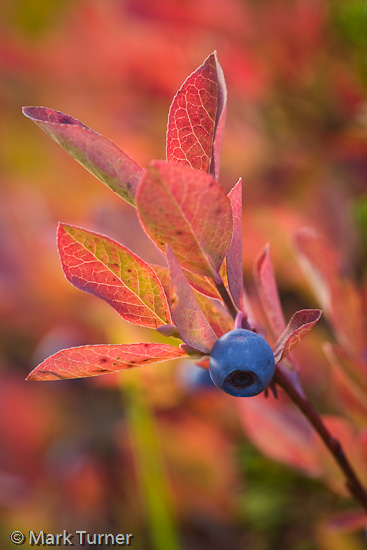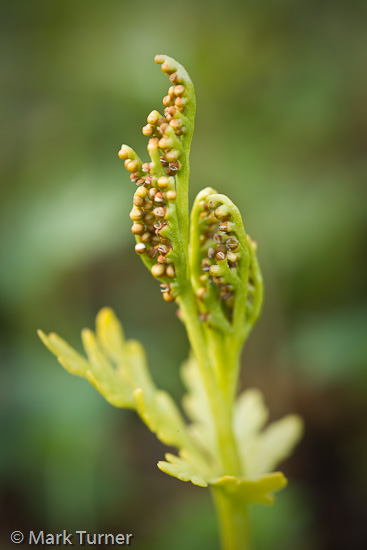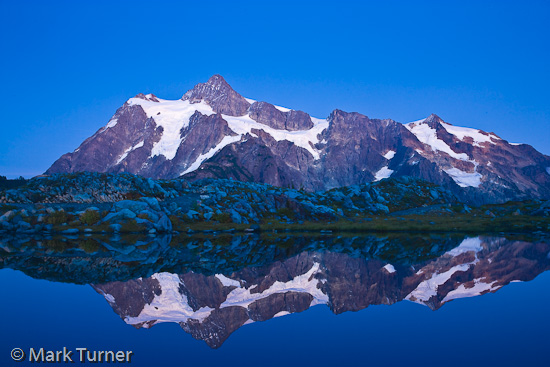Deliciosum
 I had a family portrait session reschedule from Sunday afternoon, so I took a look at the clouds to the east and decided to head up to Heather Meadows and Artist Point for some landscapes. I didn’t get out of town until after 2 pm, which was fine since I really wanted sunset at 7:10.
I had a family portrait session reschedule from Sunday afternoon, so I took a look at the clouds to the east and decided to head up to Heather Meadows and Artist Point for some landscapes. I didn’t get out of town until after 2 pm, which was fine since I really wanted sunset at 7:10.
This is the season to pick wild blueberries and I ran into several people on the trail who had big containers of the tasty fruit. The photo here is of a Cascades Blueberry, which has the very appropriate Latin name of Vaccinium deliciosum. They’re indeed among the tastiest of our native blueberries (which some folks call huckleberries). This was a case of being able to eat my subject after finishing photographing it.
I picked and ate a goodly number of blueberries along the trail, savoring the sweet morsels. I didn’t take a container to bring any home, but if I had I certainly could have filled it without much difficulty.
My other favorite species is the Black Huckleberry, Vaccinium membranaceum. They grow on bigger shrubs and don’t produce as much fruit.
While the blueberries were nearly everywhere along the Bagley Lakes Trail, the botanical gem of the day was this little Alpine Wintergreen, Gaultheria humufusa. It’s one of two low-growing relatives of Salal that we have in the northwest.

This was the first time I’ve found Gaultheria humufusa, although I’ve looked for it over the past several years. Our native plant society had a field trip on the same trail a couple of weeks ago and the group reported having seen it and told me where they’d found it. There was just a small patch, not much more than a meter across, on the rocks just above the trail. Each leaf is only about 3/4 inch long and the berries were a little less than 1/4 inch across.
 The Grapeferns (right) get their name because their spore-bearing structures resemble bunches of grapes. This little specimen is Lanceleaf Grapefern, Botrychium lanceolatum. It’s only about 3 inches tall and very easy to miss. I spied four plants just off the Bagley Lakes Trail. I probably would have missed them if it weren’t for another larger species of Botrychium that caught my eye within a foot of the trail.
The Grapeferns (right) get their name because their spore-bearing structures resemble bunches of grapes. This little specimen is Lanceleaf Grapefern, Botrychium lanceolatum. It’s only about 3 inches tall and very easy to miss. I spied four plants just off the Bagley Lakes Trail. I probably would have missed them if it weren’t for another larger species of Botrychium that caught my eye within a foot of the trail.
Among fern aficionados the Grapeferns are among the sought-after species. They’re uncommon, more primitive than most other ferns, generally small, and rather interesting in the way they grow and produce spores. We have several species in the North Cascades, but I don’t come across them often and when I do it’s usually in the company of someone who knows more about them than I do. The Yellow Aster Butte trail is known to be home to several Botrychiums but you’d have to know where to look to find them.
What would a day at Heather Meadows and Artist Point be without photographing Mt. Shuksan? It’s probably the most-photographed mountain in the world. Did I need another variation? Likely not. Could I resist? Of course not.

This dusk photo was made with the iconic mountain reflected in the calm waters of a small tarn toward the end of the Artist Ridge trail, just below Huntoon Point. It’s a favorite vantage point, but a little harder to get to than the standard view from Picture Lake. I met a good many people heading back to their cars as I walked out the trail to the tarn.
I knew that sunset would be about 7:10 pm so I got in position in time for the sunset light on the mountain. I’d hoped that the clouds that lingered most of the afternoon would still be around the mountain at sunset, but they dissipated before the light got sweet. Oh well. I shot the sunset, and then waited around a while.
This is the last variation I made, at 7:38 pm. The sky was starting to darken, giving a nice glow to the glaciers below the summit. I often find that I like the after-sunset light even better than earlier in the evening. Sometime I’d like to do a family portrait here.

